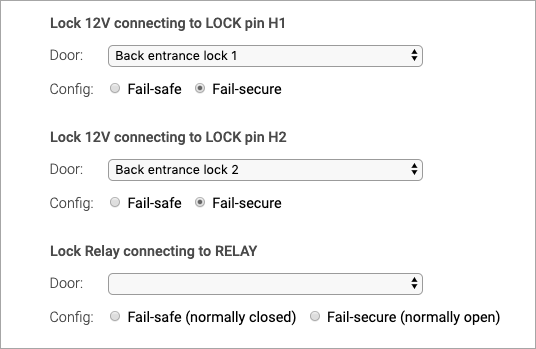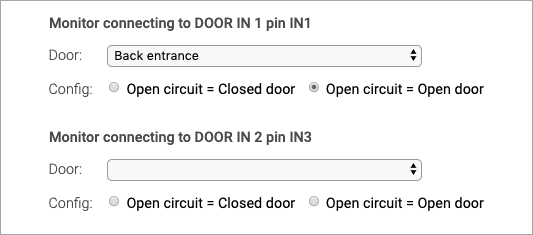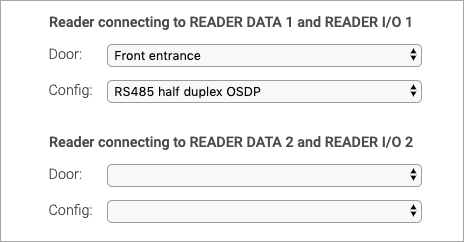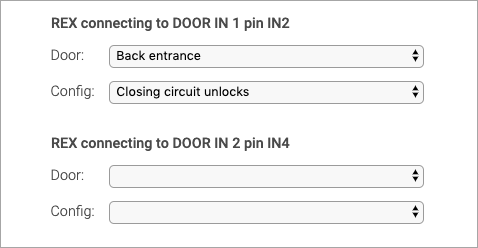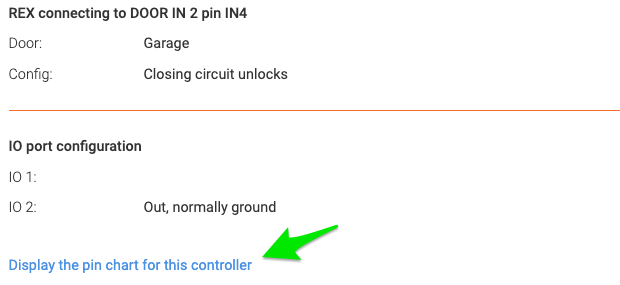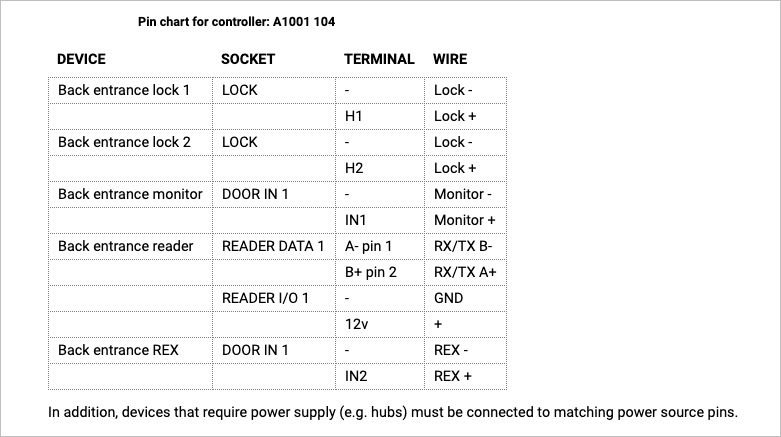A1001 settings: Difference between revisions
Telcredstaff (talk | contribs) |
Telcredstaff (talk | contribs) |
||
| (13 intermediate revisions by the same user not shown) | |||
| Line 1: | Line 1: | ||
| ⚫ | |||
The [https://www.axis.com/se/sv/products/axis-a1001 Axis A1001 Network Door Controller] can control one or two doors with electric locks or: |
|||
* one door directly and up to 16 wireless [[SimonsVoss SmartIntego]] locks via a hub |
|||
* one door directly and up to 8 wireless [[Assa Aperio]] locks via a hub |
|||
==== With direct doors only ==== |
|||
There are quite a few settings for a controller and they are all explained on this page. |
|||
The A1001 controller can control one or two doors directly, meaning that the locks, monitors, and REX devices are connected to the physical connections on the controller. |
|||
=== Name, description and time zone === |
|||
[[File:name_desc_tz.png|Name, description and time zone]] |
|||
| ⚫ | |||
It is mandatory to give the controller a ''name'' and it is optional to give it a ''description''. |
|||
| ⚫ | |||
The ''time zone'' of the controller will default to the time zone of the [[Delegation|organization]] but can be changed. |
|||
=== |
==== With SimonsVoss SmartIntego ==== |
||
In combination with wireless locks from [[SimonsVoss SmartIntego]], each controller can still manage one or two doors directly. In addition, a controller can manage up to 30 (recommended max value) wireless locks via one or more IP-connected hubs. One SmartIntego hub can manage maximum 16 doors and has a range of 20 - 30 meters. |
|||
There are two ways that a controller can connect to the Telcred service: ''O3C'' and ''Direct''. O3C stands for One-Click-Connection-Component and is a technology developed by Axis Communications. It is the default and recommended way to connect a controller, since it is both simpler and more secure than ''Direct''. |
|||
The connection between the SmartIntego hub and the controller is done on the [[Hubs|hub]] page. |
|||
==== O3C ==== |
|||
==== With Assa Aperio ==== |
|||
With O3C, it is always the controller that initiates the communication with the Telcred service. The connection is encrypted with HTTPS and since most routers and firewalls allow outgoing HTTPS traffic, there is no need to configure port forwarding or open up the firewall. |
|||
The [[Assa Aperio]] hub is connected physically to the reader socket on the A1001 and one controller can only manage one Assa Aperio hub. Hubs are available under the first dropdown list so select it here. Up to 8 Assa Aperio wireless locks can be managed by the hub. |
|||
| ⚫ | |||
[[File:connection_settings.png|O3C connection]] |
|||
In order to use O3C, it is necessary to know the MAC address of the controller (printed on the controller label as S/N) and something called OAK (Owner Authentication Key). The OAK is printed on a sticker that is included in the packaging for a new controller. If it has been lost it is possible to retrieve it by asking Axis or Telcred (in which case you need the MAC address). |
|||
Directly after saving the configuration for a new controller with O3C, the Telcred service uses the MAC and OAK to connect to a ''Dispatch server'', which is maintained by Axis Communications, and "claim" the controller. If this process is successful, the controller connection status will change to ''Ready to connect'' in the Telcred system. |
|||
At this stage, it is necessary to press the control button on the controller for 1-2 seconds. |
|||
[[File:control_button.png|Control button]] |
|||
Pressing the control button will cause the controller to connect to the Axis Dispatch server and download a small [https://en.wikipedia.org/wiki/Public_key_certificate certificate] with all the information it needs to connect to the Telcred service in a secure way. This should happen a few seconds later and when it has successfully established a connection to Telcred Access Manager, its connection status will change to ''Online''. |
|||
From this point on, the controller will always try to connect to the Telcred service after it has been offline - even if it is moved to a different network. |
|||
==== Direct ==== |
|||
With ''Direct'' communication it is the Telcred service that initiates the communication with the controller. The connection is encrypted (HTTPS), but in most cases port forwarding needs to be configured in the router and the firewall may need to be opened up. |
|||
[[File:direct_connection.png|Direct connection]] |
|||
The only information necessary for direct connection is the IP address and port number on which the Telcred service should contact the controller. Obviously, it needs to be the external IP address since the connection is initiated outside the network on which the controller sits. |
|||
=== Internal IP and Firmware version === |
|||
[[File:ip_fw.png|IP address and firmware version]] |
|||
In view mode, the internal IP address, i.e. the address on the local network, is displayed. This is only for information and the IP address cannot be changed through Telcred Access Manager. |
|||
The firmware version is also displayed, and in edit mode it is possible to [[Update firmware|update the firmware]]. |
|||
| ⚫ | |||
The A1001 controller can control one or two doors directly or: |
|||
* one door directly and up to 8 Assa Aperio doors via a hub |
|||
* one door directly and up to 16 SimonsVoss SmartIntego doors via a hub |
|||
| ⚫ | |||
| ⚫ | |||
| ⚫ | |||
=== Lock settings === |
=== Lock settings === |
||
| Line 96: | Line 45: | ||
* ''Fail-secure'' means that the door is locked if the power fails (it is secure from intruders on the outside). This is the default. |
* ''Fail-secure'' means that the door is locked if the power fails (it is secure from intruders on the outside). This is the default. |
||
* ''Fail-safe'' means that the door is unlocked if the power fails (it is safe for people on the inside, e.g. in the event of a fire). |
* ''Fail-safe'' means that the door is unlocked if the power fails (it is safe for people on the inside, e.g. in the event of a fire). |
||
When using the relay socket on the controller, connect minus (-) from the lock to minus (-) on the controller. Then connect plus (+) from the lock to RELAY pin 2 on the controller. If the lock requires voltage to operate, connect RELAY pin 3 on the controller to the required voltage (12V or 24V) on the PWR part of the socket. |
|||
=== Monitor settings === |
=== Monitor settings === |
||
| Line 142: | Line 93: | ||
Make the connection between REX device and door by using the dropdown list and specify whether opening or closing the circuit should trigger the request to exit. |
Make the connection between REX device and door by using the dropdown list and specify whether opening or closing the circuit should trigger the request to exit. |
||
A special case of using a REX device / input is where a user opens the door manually and the door has a door monitor. Normally, this will trigger the ''door forced open'' alert, but this may not be the desired behavior. In this case, it is possible to use a specific REX device that will trigger as soon as the door starts to open and configure it as either ''Closing circuit allows'' or ''Opening circuit allows''. The effect of this is to prevent the ''door forced open'' alert to be generated. |
A special case of using a REX device / input is where a user opens the door manually and the door has a door monitor. Normally, this will trigger the ''door forced open'' alert, but this may not be the desired behavior. In this case, it is possible to use a specific REX device that will trigger as soon as the door starts to open and configure it as either ''Closing circuit allows'' or ''Opening circuit allows''. The effect of this is to prevent the ''door forced open'' alert to be generated. |
||
=== IO port settings === |
|||
The A1001 Network door controller has two configurable IO ports. These ports can be used with [[Commands and triggers]]; an input port can act as a trigger, and a command can activate an output port. In order to use the IO ports, they first need to be configured. |
|||
[[File:ioport_settings.png|IO port settings]] |
|||
Each IO port can be configured either as ''input'' or ''output''. It is also necessary to define what the normal state of the port is: ''ground'' or ''open''. For more information on the use of IO ports, see the section on [[Commands and triggers]]. |
|||
=== Pin chart === |
=== Pin chart === |
||
After saving or editing the settings for an A1001 controller, Telcred Access Manager can generate a pin chart that |
After saving or editing the settings for an A1001 controller, Telcred Access Manager can generate a pin chart that summarizes the physical connections on the controller. The pin chart is accessed by clicking the link at the bottom of the controller detail screen: |
||
[[File:pin_chart_link.png|Pin chart link]] |
[[File:pin_chart_link.png|border|Pin chart link]] |
||
Latest revision as of 17:08, 13 October 2021
Door(s)
With direct doors only
The A1001 controller can control one or two doors directly, meaning that the locks, monitors, and REX devices are connected to the physical connections on the controller.
Select the first door from the dropdown list (you may need to create it first). If a second door should be controlled by this controller, select it from the second (optional) dropdown list.
With SimonsVoss SmartIntego
In combination with wireless locks from SimonsVoss SmartIntego, each controller can still manage one or two doors directly. In addition, a controller can manage up to 30 (recommended max value) wireless locks via one or more IP-connected hubs. One SmartIntego hub can manage maximum 16 doors and has a range of 20 - 30 meters.
The connection between the SmartIntego hub and the controller is done on the hub page.
With Assa Aperio
The Assa Aperio hub is connected physically to the reader socket on the A1001 and one controller can only manage one Assa Aperio hub. Hubs are available under the first dropdown list so select it here. Up to 8 Assa Aperio wireless locks can be managed by the hub.
In addition to the Assa Aperio hub, it is possible to let the controller manage one door directly. In this case, select it in the second (optional) dropdown list.
Lock settings
The A1001 controller has three lock outputs; two that deliver 12V on/off and one relay. These can be used in different configurations for a maximum of two doors, e.g.:
- One door with one 12V lock
- One door with two 12V locks
- Two doors with one 12V lock each
- One door with a 12V lock and second door with a relay controlled lock
- etc.
For each lock output that is used, it is necessary to specify which door it belongs to by using a dropdown list.
A common configuration is one door with two locks, where the second lock is locked during the night and unlocked during the day. For this configuration, the "night lock" should always be configured as "lock 2".
For each lock output that is used, it is also necessary to specify whether it should be configured as fail-safe or fail-secure:
- Fail-secure means that the door is locked if the power fails (it is secure from intruders on the outside). This is the default.
- Fail-safe means that the door is unlocked if the power fails (it is safe for people on the inside, e.g. in the event of a fire).
When using the relay socket on the controller, connect minus (-) from the lock to minus (-) on the controller. Then connect plus (+) from the lock to RELAY pin 2 on the controller. If the lock requires voltage to operate, connect RELAY pin 3 on the controller to the required voltage (12V or 24V) on the PWR part of the socket.
Monitor settings
For each door that is attached to this controller, a door monitor can be used. A common type of door monitor is a magnet sensor. The door monitor senses if the door is open or closed and has two purposes:
- A door open too long alert will be generated if the door is open too long (configurable for each door).
- A "door forced open" alert will be generated if the door is opened without a prior access granted event, such as presenting a valid credential to the reader or using the REX button (see below).
There are two monitor inputs; one on socket DOOR IN 1 and one on DOOR IN 2.
Make the connection between monitor input and door by using the dropdown list. Also specify if an open circuit means that the door is open or closed. The default is open circuit = open door.
Reader settings
Maximum two readers can be attached to the A1001 controller (or one if a hub is used). Possible combinations include:
- One door and one reader
- Two doors and one reader each
- One door with two readers (one for each direction)
- No readers at all (if only credentials of type Remote are used)
Make the connection between reader socket and door by using the dropdown list.
Also specify the type of reader. Supported reader types are:
- RS485 half duplex OSDP
- Wiegand single LED
- Wiegand double LED
REX settings
REX (Request to EXit) devices are inputs that trigger by either opening or closing a circuit. A typical REX device is an "open button" that unlocks (or more exactly; grants access to) the door from the inside. Maximum two REX devices can be attached to an A1001 controller.
Make the connection between REX device and door by using the dropdown list and specify whether opening or closing the circuit should trigger the request to exit.
A special case of using a REX device / input is where a user opens the door manually and the door has a door monitor. Normally, this will trigger the door forced open alert, but this may not be the desired behavior. In this case, it is possible to use a specific REX device that will trigger as soon as the door starts to open and configure it as either Closing circuit allows or Opening circuit allows. The effect of this is to prevent the door forced open alert to be generated.
IO port settings
The A1001 Network door controller has two configurable IO ports. These ports can be used with Commands and triggers; an input port can act as a trigger, and a command can activate an output port. In order to use the IO ports, they first need to be configured.
Each IO port can be configured either as input or output. It is also necessary to define what the normal state of the port is: ground or open. For more information on the use of IO ports, see the section on Commands and triggers.
Pin chart
After saving or editing the settings for an A1001 controller, Telcred Access Manager can generate a pin chart that summarizes the physical connections on the controller. The pin chart is accessed by clicking the link at the bottom of the controller detail screen:

